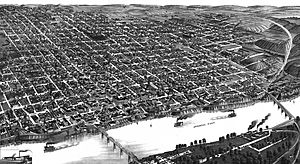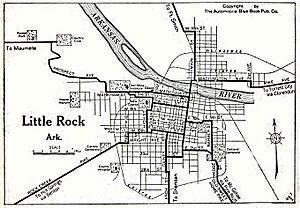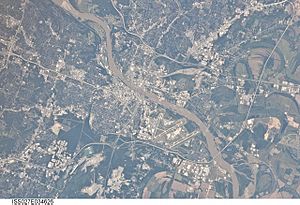Timeline of Little Rock, Arkansas facts for kids
Welcome to a timeline of Little Rock, Arkansas! This page tells the story of how Little Rock grew from a small trading post into the capital city it is today. You'll discover important events, people, and changes that shaped this amazing city over hundreds of years.
Early Little Rock History
- 1722 – A French explorer named Jean-Baptiste Benard de la Harpe landed near a small rock formation on the Arkansas River. He called it la Petite Roche, which means "the little rock." He built a trading post nearby. The Quapaw Indians lived in the area.
- 1812 – William Lewis, a fur trapper, built a temporary home near the little rock.
- 1814 – Colonel Edmund Hogan built the first permanent home and a ferry at the little rock. This was where a road from Missouri crossed the Arkansas River.
- 1819 – The Arkansas Gazette, an important newspaper, was started.
- 1820
- Little Rock was officially surveyed, meaning its boundaries were mapped out.
- A law firm, which later became the Rose Law Firm, started. It is one of the oldest law firms west of the Mississippi River.
- 1821
- Little Rock became the capital of the Arkansas Territory. It also became the main town for Pulaski County.
- For a short time, Little Rock was called "Arkopolis."
- 1826 – Robert Cunningham was the first free child born in Little Rock.
- 1831 – Little Rock officially became a city.
- Dr. Matthew Cunningham was elected as the first mayor of Little Rock.
- 1833 – The Arkansas State House began construction. It was finished in 1842 and served as the state capitol until 1911.
- 1836
- Arkansas became the 25th state in the United States. Little Rock was chosen as its official capital city.
- 1838 – A steam ferry started operating, making travel easier.
- 1841 – The Tower Building of the Little Rock Arsenal was completed. It was used to store U.S. military supplies. Today, it's the MacArthur Museum of Military History.
- 1843 – Mount Holly Cemetery, a historic burial ground, was established.
- 1850 – The city's population was 2,167 people.
- 1860 – The population grew to 3,727 people.
Little Rock During the Civil War
- 1861
- U.S. military supplies at the Little Rock Arsenal were surrendered to Governor Henry M. Rector.
- Arkansas joined the Confederacy during the American Civil War.
- 1863
- Union forces took control of Little Rock.
- 1864 – 17-year-old David Owen Dodd died on January 6. He was accused of being a Confederate spy.
- 1866 – The Little Rock Police Department was formed to keep the city safe.
- 1868 – The Little Rock National Cemetery was established.
- 1870 – The population grew to about 12,000 people.
- 1873 – The Baring Cross Bridge was built across the Arkansas River.
- 1874 – The Brooks-Baxter War, a political conflict, took place in Little Rock.
- 1876 – Horse-drawn trams began operating, helping people get around.
- 1877 – Walden Seminary, a college, was founded.
- 1879 – Telephone service began operating in the city.
- 1880 – General Douglas MacArthur, a famous military leader, was born in the Tower Building of the Little Rock Arsenal.
- 1881 – The Little Rock United States Post Office and Courthouse was built.
- 1882 – The Cathedral of St. Andrew was built.
- 1883 – The Mosaic Templars of America, a Black fraternal organization, was founded.
- 1884 – A waterworks system was built, providing clean water to the city.
- 1887 – Electric streetcars were planned for the city.
- 1888 – Electric street lighting was installed, making the city brighter at night.
- 1890 – The area known as Argenta became part of Little Rock for a while. The population was 25,874.
- 1891 – Electric streetcars began operating, replacing the horse-drawn ones.
- 1892 – The Fire Department was established.
- 1900 – The population reached 38,307 people.
Little Rock in the 20th Century
Early 1900s
- 1908 – Little Rock College opened.
- 1910 – A public library opened. The population was 45,941.
- 1911 – The current Arkansas State Capitol building was completed. This is the building where the state government works today.
- 1916 – Pulaski Heights, an early suburb, became part of the city. This allowed Little Rock to grow westward.
- 1917 – A special branch of the Little Rock Public Library for African Americans opened.
- 1924 – The Federal Reserve Bank building was constructed.
- 1926
- KLRA radio began broadcasting.
- The Little Rock Zoo was founded, giving families a place to see animals.
- 1927
- Little Rock Junior College was established.
- Little Rock Senior High School was built.
- 1929 – Dunbar Junior and Senior High School and Junior College, an important school for African American students, was established.
- 1930 – KARK radio began broadcasting.
- 1932 – Travelers Field, a baseball park, opened.
- 1937 – The Museum of Fine Arts was founded.
- 1940 – The population reached 88,039 people.
- 1941 – The Historic Arkansas Museum opened.
- 1948 – War Memorial Stadium (Arkansas), a large sports stadium, opened.
Mid to Late 1900s
- 1950
- The Arkansas Governor's Mansion was built.
- Little Rock's population went over 100,000 people.
- 1951 – Pratt C. Remmel became mayor, the first Republican mayor since 1887.
- 1953 – KATV television began broadcasting.
- 1955 – Little Rock Air Force Base was activated near the city.
- 1957 – The Little Rock Nine tried to enroll at Little Rock Central High School. The Arkansas National Guard, ordered by Governor Orval Faubus, tried to stop them. President Dwight Eisenhower sent federal troops to protect the students and make sure they could go to school. This event is known as the Crisis at Central High.
- 1958 – Governor Faubus closed all three public high schools in Little Rock for a year to try and stop desegregation.
- 1960 – The Arkansas Arts Center was founded.
- 1964 – Dillard's, a large department store company, made Little Rock its main office.
- 1967 – University Mall, a shopping center, opened.
- 1968 – New tall buildings, like the Worthen Bank Building, were constructed downtown.
- 1971 – Heifer International, a charity that helps people around the world, made Little Rock its main office.
- 1974 – The First National Bank building was built. It became the city's tallest building at 454 feet (138 meters) tall.
- 1975 – The Central Arkansas Library System made Little Rock its main office.
- 1976 – The Arkansas Repertory Theatre was founded.
- 1979 – Webster Hubbell became mayor.
- 1980 – The population reached 158,461 people.
- 1983 – Little Rock became a sister city with Kaohsiung, Taiwan.
- 1986
- The Capitol Tower was completed. At 547 feet (167 meters) tall, it became the tallest building in Arkansas.
- 1987 – Lottie Shackelford became mayor.
- 1990 – The population reached 175,795 people.
- 1991 – The Arkansas Gazette and Arkansas Democrat newspapers merged to become the Arkansas Democrat-Gazette.
- 1992
- Bill Clinton's presidential campaign was based in Little Rock.
- November 3: Bill Clinton, from Arkansas, was elected President of the United States. He gave his acceptance speech from the Old State House.
- Little Rock became a sister city with Hanam, South Korea.
- 1994 – Little Rock became a sister city with Changchun, China.
- 1995 – Jim Dailey became mayor.
- 1997
- A new National Park Service visitor center opened to mark 40 years since the Crisis at Central High.
- March 1: A powerful tornado hit the city's southern and eastern areas, causing damage and sadly, deaths.
- 1999
- January 21: Another tornado caused serious damage to buildings south of downtown.
- June 1: American Airlines Flight 1420 crashed after landing at Adams Field, leading to some deaths.
- 2000 – Little Rock's core metropolitan area population was 610,518.
Little Rock in the 21st Century
- 2001 – Little Rock became a friendship city with Newcastle upon Tyne, England.
- 2003
- The first Little Rock Marathon was held, with many runners participating.
- Little Rock resident Wesley Kanne Clark, a retired general, announced he would run for president.
- 2004
- The William J. Clinton Presidential Center opened. Many important people, including former presidents, attended the opening.
- The River Rail Streetcar began operating, offering rides downtown.
- 2005 – The Jack Stephens Center, an arena, opened.
- 2006
- Heifer International opened its new world headquarters in downtown Little Rock.
- The Pulaski County Pedestrian and Bicycle Bridge, also called the Big Dam Bridge, opened. It's the world's longest bridge built just for walking and biking.
- 2007
- Dickey-Stephens Park, home to the Arkansas Travelers baseball team, opened in North Little Rock.
- January: Mark Stodola became mayor.
- 2008 – The Mosaic Templars Cultural Center opened.
- 2010 – Little Rock's city population was 193,524.
- 2011 – Little Rock recorded its highest temperature ever: 114 degrees Fahrenheit (45.6 degrees Celsius) in August.
- 2018 – Frank Scott Jr. became the first African-American mayor of Little Rock to be elected by the people.
- 2023 – A tornado hit North Little Rock as part of a larger Tornado outbreak of March 31 – April 1, 2023.
|

All content from Kiddle encyclopedia articles (including the article images and facts) can be freely used under Attribution-ShareAlike license, unless stated otherwise. Cite this article:
Timeline of Little Rock, Arkansas Facts for Kids. Kiddle Encyclopedia.




